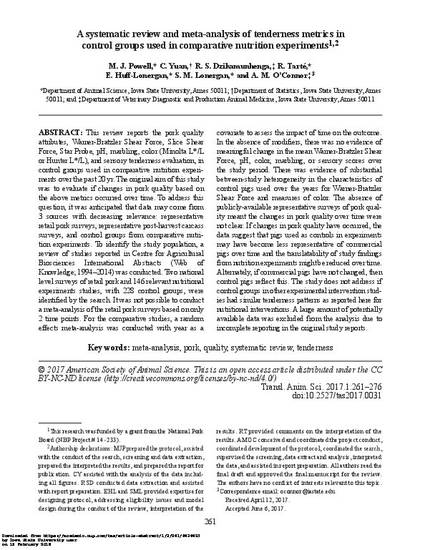
This review reports the pork quality attributes, Warner-Bratzler Shear Force, Slice Shear Force, Star Probe, pH, marbling, color (Minolta L*/L or Hunter L*/L), and sensory tenderness evaluation, in control groups used in comparative nutrition experiments over the past 20 yr. The original aim of this study was to evaluate if changes in pork quality based on the above metrics occurred over time. To address this question, it was anticipated that data may come from 3 sources with decreasing relevance: representative retail pork surveys, representative post-harvest carcass surveys, and control groups from comparative nutrition experiments. To identify the study population, a review of studies reported in Centre for Agricultural Biosciences International Abstracts (Web of Knowledge; 1994–2014) was conducted. Two national level surveys of retail pork and 146 relevant nutritional experiments studies, with 228 control groups, were identified by the search. It was not possible to conduct a meta-analysis of the retail pork surveys based on only 2 time points. For the comparative studies, a random effects meta-analysis was conducted with year as a covariate to assess the impact of time on the outcome. In the absence of modifiers, there was no evidence of meaningful change in the mean Warner-Bratzler Shear Force, pH, color, marbling, or sensory scores over the study period. There was evidence of substantial between-study heterogeneity in the characteristics of control pigs used over the years for Warner-Bratzler Shear Force and measures of color. The absence of publicly-available representative surveys of pork quality meant the changes in pork quality over time were not clear. If changes in pork quality have occurred, the data suggest that pigs used as controls in experiments may have become less representative of commercial pigs over time and the translatability of study findings from nutrition experiments might be reduced over time. Alternately, if commercial pigs have not changed, then control pigs reflect this. The study does not address if control groups in other experimental intervention studies had similar tenderness patterns as reported here for nutritional interventions. A large amount of potentially available data was excluded from the analysis due to incomplete reporting in the original study reports.
Available at: http://works.bepress.com/elisabeth_huff-lonergan/126/

This article is published as Powell, M. J., C. Yuan, R. S. Dzikamunhenga, R. Tarté, E. Huff-Lonergan, S. M. Lonergan, and A. M. O'Connor. "A systematic review and meta-analysis of tenderness metrics in control groups used in comparative nutrition experiments." Translational Animal Science 1, no. 3 (2017): 261-276. doi; 10.2527/tas2017.0031. Posted with permission.